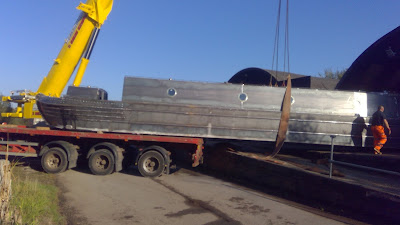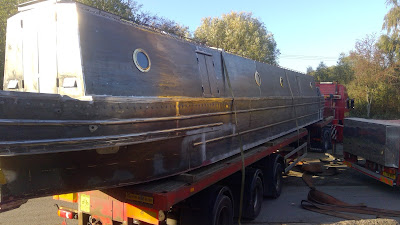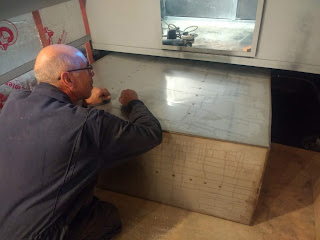At the time of the last post, I'd completed some of the wiring, but was halted as I didn't have a crimper big enough to handle the 70mm2 cables that had to run from the domestic battery bank to the inverter. At full power, the inverter will be pulling 200A from the batteries, so the cables and connections need to be rated appropriately.
Once I had the crimper, it was on to the heavy cabling in earnest. A friend of mine made a couple of bespoke brackets to hold the big 400A isolator switches. These need to be mounted as close as possible to the batteries. Power is then fed through a megafuse to the busbar and is distributed from that point.
It's surprising just how many connections needed to be made to the busbars! I was careful to make the installation as neat as possible, to facilitate tracing and fault-finding if required. Any loose cables were routed in convoluted pipe to prevent chafing.
 |
| 24V busbars |
 |
| Starter battery islolation switch |
The temperature sensors for the inverter and A2B charger were connected to battery negative and an additional fused supply was taken off to provide unswitched power for the bilge pumps.
The Victron Colour Control unit was connected to the inverter and MPPT controller using the VE Bus and VE Direct cables. It's an impressive piece of kit that tells you what's going on around the system.
That completed the 'power' side of the 24V electrics. The next phase will involve taking cables from the distribution box out to the various lights, pumps and other 24V equipment. The installation just needs labels applying to the key components.
Best practice is to keep 230V AC cables separate from the low voltage DC ones. So the AC is fed through trunking below the gunwale and the DC stuff through trunking in the roof. This is one way the Celotex insulation has worked out very well. The roof has two layers of 12mm, which made a level with the steel roof bearers. I then fixed 25mm battens lengthwise and ran two 25mm x 40mm plastic trunkings right down the boat. The spaces in between were filled with a final layer of 25mm Celotex, giving a total of 49mm under the roof.
Best practice is to keep 230V AC cables separate from the low voltage DC ones. So the AC is fed through trunking below the gunwale and the DC stuff through trunking in the roof. This is one way the Celotex insulation has worked out very well. The roof has two layers of 12mm, which made a level with the steel roof bearers. I then fixed 25mm battens lengthwise and ran two 25mm x 40mm plastic trunkings right down the boat. The spaces in between were filled with a final layer of 25mm Celotex, giving a total of 49mm under the roof.
 |
| Showing trunking in roofspace |
By routing a channel, it should be a relatively easy matter to break out of the trunking to supply lights and other equipment.
With the ceiling insulation finshed (hooray!) between the engine room bulkhead and the forward bulkhead, I could now turn my attention to getting that battened and insulated, as it was one of the last remaining areas of bare steel.























































